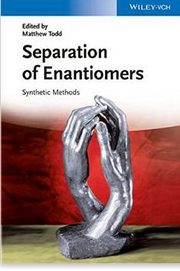 [about the author]
[about the author]An Associate Professor at The University of Sydney's School of Chemistry, Matthew Todd gained his BA and PhD from Cambridge University, UK, where he later became a Fellow in Chemistry. Prior to taking up his current position, he was a Wellcome Trust postdoctoral fellow at the University of California, Berkeley, USA, from 1999 to 2000, and then became a lecturer in organic chemistry at the Department of Chemistry, Queen Mary, University of London from 2001 to 2005. Prof. Todd's research group is investigating synthetic methodology, responsive metal complexes, and asymmetric catalysis. He has received awards for his work in open science, most notably his creation of the Open Source Malaria consortium that is trialling a new model of drug discovery.
[Table of Contents]
INTRODUCTION: A SURVEY OF HOW AND WHY TO SEPARATE ENANTIOMERS
Classical Methods
Kinetic Resolution ('KR')
Dynamic Kinetic Resolution ('DKR')
Divergent Reactions of a Racemic Mixture ('DRRM')
Other Methods
STOICHIOMETRIC KINETIC RESOLUTION REACTIONS
Introduction
Kinetic Treatment
Chiral Reagents and Racemic Substrates
Enantiodivergent Formation of Chiral Product
Enantioconvergent Reactions
Diastereomer Kinetic Resolution
Some Applications of Kinetic Resolution
Conclusion
CATALYTIC KINETIC RESOLUTION
Introduction
Kinetic Resolution of Alcohols
Kinetic Resolution of Epoxides
Kinetic Resolution of Amines
Kinetic Resolution of Alkenes
Kinetic Resolution of Carbonyl Derivatives
Kinetic Resolution of Sulfur Compounds
Kinetic Resolution of Ferrocenes
Conclusions
APPLICATION OF ENZYMES IN KINETIC RESOLUTIONS, DYNAMIC KINETIC RESOLUTIONS AND DERACEMIZATION REACTIONS
Introduction
Kinetic Resolutions Using Hydrolytic Enzymes
Dynamic Kinetic Resolution
Deracemization
Enantioconvergent Reactions
Conclusions
DYNAMIC KINETIC RESOLUTION (DKR)
Introduction
Definition and Classification
Dynamic Kinetic Resolution (DKR)
Mathematical Expression
DKR-Related Methods
Concluding Remarks
ENANTIODIVERGENT REACTIONS: DIVERGENT REACTIONS ON A RACEMIC MIXTURE AND PARALLEL KINETIC RESOLUTION
Introduction: The Conceptual Basis for Kinetic Resolution and Enantiodivergent Reactions
Divergent RRM Using a Single Chiral Reagent: Ketone Reduction
Divergent RRM under Oxidative Conditions
Organometallic Reactions and Regiodivergent RRM
Regiodivergent RRM in Selective Reactions of Difunctional Substrates
Divergent RRM Using Two Chiral Reagents: Parallel Kinetic Resolution (PKR)
Conclusion
RARE, NEGLECTED AND POTENTIAL SYNTHETIC METHODS FOR THE SEPARATION OF ENANTIOMERS
Resolution through the Selfish Growth of Polymers: Stereoselective Polymerization
Resolution through Photochemical Methods
Combinations of Crystallization and Racemization
Destruction then Recreation of Stereocentres: Enantioselective Protonations
Dynamic Combinatorial Chemistry
Asymmetric Autocatalysis
Miscellaneous
Concluding Remarks
Index

 新书报道
新书报道